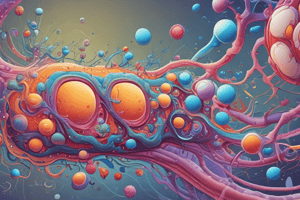Podcast
Questions and Answers
What is the main function of cholesterol in the lipid bilayer?
What is the main function of cholesterol in the lipid bilayer?
- To serve as receptors for hormones
- To synthesize proteins
- To determine the fluidity of the membrane (correct)
- To provide a barrier for water-soluble substances
What is the main difference between integral and peripheral proteins?
What is the main difference between integral and peripheral proteins?
- Integral proteins extend through the whole thickness of the membrane, while peripheral proteins are attached to one side (correct)
- Integral proteins are attached to the outer surface of the membrane, while peripheral proteins are embedded in the membrane
- Integral proteins are found in the lipid bilayer, while peripheral proteins are found in the cytoplasm
- Integral proteins are small, while peripheral proteins are large
What is the main function of phospholipids in the cell membrane?
What is the main function of phospholipids in the cell membrane?
- To determine the fluidity of the membrane
- To serve as receptors for hormones
- To provide a barrier for water-soluble substances (correct)
- To synthesize proteins
What is the function of carbohydrates on the outer surface of the cell membrane?
What is the function of carbohydrates on the outer surface of the cell membrane?
What is the primary component of the lipid bilayer?
What is the primary component of the lipid bilayer?
What is the term for carbohydrates attached to proteins or lipids on the outer surface of the cell membrane?
What is the term for carbohydrates attached to proteins or lipids on the outer surface of the cell membrane?
What is the main function of integral proteins?
What is the main function of integral proteins?
What is the percentage of proteins in the cell membrane?
What is the percentage of proteins in the cell membrane?
What is the main function of the lipid bilayer?
What is the main function of the lipid bilayer?
Which of the following is NOT a function of carbohydrates on the outer surface of the cell membrane?
Which of the following is NOT a function of carbohydrates on the outer surface of the cell membrane?
Flashcards are hidden until you start studying
Study Notes
Cell Membrane Structure
- The cell membrane is composed of lipid bilayer (42%), proteins (55%), and carbohydrates (3%).
- The lipid bilayer is continuous over the entire surface, providing a barrier that prevents the movement of water-soluble (lipid-insoluble) substances.
Lipid Bilayer
- The lipid bilayer is made up of phospholipid (the major lipid in the cell membrane) and cholesterol.
- Phospholipid molecules are 2 molecules in thickness, with each molecule having:
- A head containing the phosphate radical, which is relatively water-soluble (hydrophilic) and exposed to water inside or outside the cell.
- Tails containing the fatty acid radical, which is relatively water-insoluble (hydrophobic) and present in the water-poor interior of the membrane.
- Cholesterol is lipophilic and dissolves in the phospholipid bilayer, helping to determine the permeability of the lipid layer to water-soluble substances and the fluidity of the membrane.
Proteins
- Proteins do not form a continuous layer in the cell membrane, instead existing as globular masses floating in the lipid bilayer.
- There are two types of proteins:
- Integral proteins, which extend through the whole thickness of the membrane and have functions such as:
- Receptors for hormone action.
- Ion channels for ion passage.
- Carriers for transporting substances like glucose and amino acids.
- Enzymes.
- Peripheral proteins, which are attached to the cell membrane from outside or inside and do not extend through the whole thickness of the membrane, often acting as enzymes.
- Integral proteins, which extend through the whole thickness of the membrane and have functions such as:
Carbohydrates (Cell Glycocalyx)
- Carbohydrates are present on the outer surface of the cell membrane, forming a loose coat called glycolcalyx.
- They may be combined with proteins (glycoproteins) or lipids (glycolipids).
- Functions of carbohydrates include:
- Receptors.
- Attaching cells to each other.
- Immune response.
- Providing an overall negative surface charge to most cells.
Studying That Suits You
Use AI to generate personalized quizzes and flashcards to suit your learning preferences.




